|
Autoharps for People with Short Arms - From Riverboat Music(tm),
This is a sort of supplement to the our buyers' guide for autoharps. That article has brought us a lot of reader questions, most of which had answers. Here's one that doesn't, exactly, have a good answer. What if you want to play autoharp but you are prevented from playing one in upright position (the way most folks hold them today) by short arms, or nerve damage or something else that makes it impractical or painful?
Note About Availability: Although this page is in a buyers' guide site that usually has a lot of links to places you can buy recommended products, none of the instruments on this page are available from any vendor I have a relationship with. - The Oscar Schmidt and Chromaharp instruments listed here have not been made since the 1960s and are almost impossible to find in playable or restorable condition.
- The Evo Bluestein 'Sparrowharp' shown further down must be custom-ordered from a luthier such as Pete D'aigle of d'Aigle Autoharps.
These instruments are shown simply to give folks with short arms, or muscle or nerve issues, some idea of the things they might consider - or consider looking for - if the size, shape or weight of a full-sized autoharp is inconvenient or painful. We hope you find it helpful.
Now for some of the choices you might consider if playing a full-sized autoharp is awkard or painful.
Consider Horizontal Position
 First of all, have you considered playing your autoharp laying on a table or in your lap, the way they used to be played? If you look at the most popular older Oscar Schmidt autoharps, frequently called "Model 73," you'll see that there is a lot of room between the chord bars and the bridge. The expectation was that you would lay the thing in front of you, push the buttons with your left hand, and strum or pick over the paper with the note names with your right. First of all, have you considered playing your autoharp laying on a table or in your lap, the way they used to be played? If you look at the most popular older Oscar Schmidt autoharps, frequently called "Model 73," you'll see that there is a lot of room between the chord bars and the bridge. The expectation was that you would lay the thing in front of you, push the buttons with your left hand, and strum or pick over the paper with the note names with your right.
Though the picture above shows a century-old 12-chord instrument, Oscar Schmidt did make 5 chord versions well into the 1960s, so you might find one that's not quite a museum piece to sell. Alternately, you could buy a modern instrument (probably a 15-chorder) and move the chord bars to give you more room on the 'south' end - don't laugh, autoharp players do worse things to their instruments.
Consider Over-the-Knee Position
Okay, call me stupid. I always thought the concave edge of autoharps was either ornamental, or, in later versions, to help you reach around with your left hand better.
It wasn't until I was investigating smaller harps that I realized that dip was made to go over your right knee, the same way a guitar does. This is actually quite comfortable with smaller harps like the OS6, OS10 and early Zimmerman (shown below). Slightly less comfortable, but still possible with a full-sized Type A or type B OS Autoharp or contemporary Chromanarps.
Remember, the autoharp wasn't built to play "upright" like players do today. That changed when early Mountain-music inspired folks like the Carter Family started playing venues or recording in studios with a single microphone (almost all venues and studios in those days). Soloists moved in and out as their turn to "shine" came and went.
And the only way an autoharp player could do that was by holding the thing vertically. But you don't have to do it that way.
What About Obsolete and Hard-to-Find Instruments?
Over the years, Oscar Schmidt and Chromaharp made several instruments that could be played in an upright position by people with short arms. None of these are being manufactured today, and all of them are almost impossible to find used in restorable - much less playable - condition. But on the off chance that one turns up while you're looking for this sort of thing, we're posting what we have been able to can find out about them.
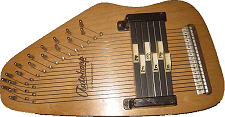 OS 6 - EasyChord OS 6 - EasyChord
Oscar Schmidt's "itty bitty" 6-chord "Easychord" instruments were marketed for children in the early 1980s, but sometimes snapped up by adults who played them just for fun. They were available in several finishes, with natural and red being the most common.
Interestingly, the first year they were only a block of wood, after which they were made hollow like other OS autoharps.
Chords are Bb, F, C7, C, D7, G, which should technically allow you to play three-chord songs in F, C, and G.
Since I first wrote this article, I've accumulated several that I use for my workshops. A few of them needed repair, but most of which were playable as soon as they were tuned.
 Chromaharp's "Miniharp" - Chromaharp made a similar instrument with only five chords (Bb, F, C7, C, and G), called a "Miniharp." Theoretically this would allow you to play three-chord songs in F and C. 19 strings. There would be room for several more chord bars if you don't mind building your own and maybe adapting the chord bar holders from a 10- or 12-chorder. Chromaharp's "Miniharp" - Chromaharp made a similar instrument with only five chords (Bb, F, C7, C, and G), called a "Miniharp." Theoretically this would allow you to play three-chord songs in F and C. 19 strings. There would be room for several more chord bars if you don't mind building your own and maybe adapting the chord bar holders from a 10- or 12-chorder.
The strings are longer than those on the EasyChord, and they have a good sound. That said, the EasyChord is more solid and has more chords, so that would be my preference.
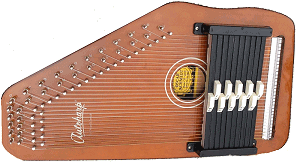 OS 10 Sierra OS 10 Sierra
For a time, OS produced the 10-chord Oscar Schmidt OS10, advertised as a 3/4-sized autoharp. It came in at least three colors, red, brown, and yellow-green (something like the color of Mountain Dew spilled on a white tablecloth). The model names include hints as to the color, such as (OS10RD, OS10BR, OS10PY, respectively).
These can play in more keys than many 'harps because they sacrificed the seventh chords to add more major chords. That said, they departed from the chord arrangements then available on most OS 'harps, and that made them less desirable to some folks.
This may be the first commercial OS autoharp before the relatively recent (and much larger) Americana to include Bm, making it relatively guitar-friendly (though not fiddle-friendly - you can't play in A or E). 30 strings.
Personally I think these would be decent starter 'harps for smaller people, if only more of them were available. Don't put off getting an autoharp until you can find one of these, though. In recent years, they've become almost impossible to find.
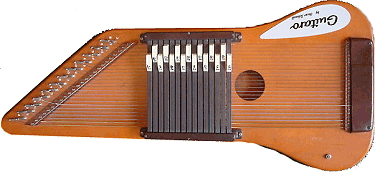 Oscar Schmidt Guitaro Oscar Schmidt Guitaro
Now for the "Keytar" of autoharps, the Oscar Schmidt "Guitaro." It's hard to say if more of these were made than the scaled-down autoharps above, but more seem to have survived. Perhaps beause they weren't marketed to children. They were released in the early-to-mid 1960s when the Folk Revival was in full swing, and guitar players were dominating the music scene. In theory, you hold it like a guitar and reach your left hand under and around the chord bars to push the buttons. They have more strumming area than all other models combined. Autoharp players are suspicious of them because of the location of the buttons - they don't look like they should force the whole cord bar down. But I'm told that the buttons has a scissor mechanism that applied equal pressure the length of the bar.
Two versions were made, the one shown and another one that had a resonator attached to the back. The mechanism was the same.
24 strings. The fifteen chords (in Circle-of-Fifths sequence) are Bb, F, C, C7, G, G7, Gm, D, D7, Dm, A7, Am, E7, Em, and B7, almost enough to play most Folk-based songs that were getting airplay. I believe it's the first Oscar Schmidt autoharp to include B7; needed for songs like "Walk Right In." That said, I would gladly trade, say, the Bb, C7 and G7 for, A, E, and Bm. There's room on the instrument for more chord bars, if you want. Though, truth be told, I doubt the thing would have been successful even if it was totally "Folk-friendly" - it's just too hokey-looking.
Today you see folks playing them in the 60-degree position and in lap position. You also see the chord bars moved down so the thing can be played in a more upright position.
Some folks have even put the 21-chord conversion kits on the things. Though with their 24-string structure they'll never have the sound of a 36 or 37-stringed autoharp, the longer songboard shouldn't exactly hurt the sound.
 Chromaharp's Chromalin - Never one to be left in the dust, Chromaharp made their own version, called the Chromalin. It differs chiefly in having the buttons near the center of the chord bars, so reaching them while holding the device in a guitar position is nearly impossible, but leaving out the scissors mechanism means that there is less to break down. Chromaharp's Chromalin - Never one to be left in the dust, Chromaharp made their own version, called the Chromalin. It differs chiefly in having the buttons near the center of the chord bars, so reaching them while holding the device in a guitar position is nearly impossible, but leaving out the scissors mechanism means that there is less to break down.
The other "downside" to the Chromalin being used for its intended purpose (as a quasi-guitar for Folk groups) is that it kept the standard 15-chord setup, so it was less "Folk-friendly." It did have a solid spruce top, and some folks who've come across these in recent years have found them fun to play. That said, properly restored, it would be a dandy instrument for a short-armed person who wanted to hold an autoharp upright without dislocating their shoulder.
 Chromaharp even made an electric version called the "Electric Chroma II" (CAP 2525) with a shape that was apparently inspired by Fender Jaguar guitars and - get this - individually geared tuning pegs. 15 chords, 36 strings, and an electric pickup. It's ugly, but might have been practical, unless the tuning pegs sticking out the back interfered with your collarbone when you tried to hold it upright. Chromaharp even made an electric version called the "Electric Chroma II" (CAP 2525) with a shape that was apparently inspired by Fender Jaguar guitars and - get this - individually geared tuning pegs. 15 chords, 36 strings, and an electric pickup. It's ugly, but might have been practical, unless the tuning pegs sticking out the back interfered with your collarbone when you tried to hold it upright.
At the moment I own one I've never tuned because the tuning tool, a sort of reverse slot-headed screwdriver is unavailable and I haven't been able to fabricate one to my liking.
 Early, Early Autoharps - Before there were Oscar Schmidt Autoharps, there were Zimmerman Autoharps, sometimes called Phonoharps. These were almost diatonic; the notes were all from the C scale except for two Bbs in the upper registers. Early, Early Autoharps - Before there were Oscar Schmidt Autoharps, there were Zimmerman Autoharps, sometimes called Phonoharps. These were almost diatonic; the notes were all from the C scale except for two Bbs in the upper registers.
A lot of these have cracked soundboards which - surprisingly, don't usually affect the sound or playability. But you'll want to look at these carefully.
In other words, don't buy one of these sight unseen, unless you're getting it for a low enough price to jusify using it as a wall decoration if it turns out not to be playable.
Later versions tended to be black, with fancy colored decals. Many are labeled "The Favorite" on the piece that covers the ends of the strings (missing from this specimen).
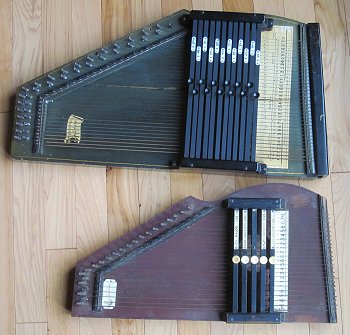 The photo to the left shows this autoharp up against the standard Oscar Schmidt Type A to give you an idea of its relative size. The photo to the left shows this autoharp up against the standard Oscar Schmidt Type A to give you an idea of its relative size.
When I decided to add the Zimmerman to this article, I spent about an hour getting it cleaned up enough to photograph. I also tuned it just to see if I could. Only one string broke, which is amazing considering that these strings are something like 125 years old. But here's another caveat: Avoid ancient autoharps if you're allergic to dust or mold. This one had no mold as far as I could tell, but some of the harps I've bought for my research had a nice crop growing inside where you couldn't do anything about it. But just cleaning this one up enough to photograph gave me an all-day headache, and I'm not particularly allergic to anything except stupid people.
Because this hadn't been tuned for decades, I'll need to retune it two or three more times to determine if it's worth restringing and refelting. (And maybe adding a few chord bars - it is sinfully lacking in relative minors and Sharp keys). But it is a VERY handy size, even for a player with long arms, like me.
 One more caveat: In those early days, when people clammored for more chords, Zimmerman issued a few instruments that added the ability to slide the chord bars over as well as pushing them down. The little egg-shaped felts you see in the photo to the right would deaden the strings they were pushed up against, giving these harps more chords. One more caveat: In those early days, when people clammored for more chords, Zimmerman issued a few instruments that added the ability to slide the chord bars over as well as pushing them down. The little egg-shaped felts you see in the photo to the right would deaden the strings they were pushed up against, giving these harps more chords.
Very few of these in any kind of playable condition has survived to this day.
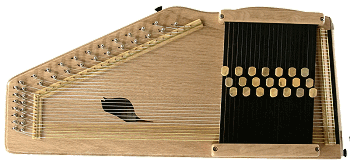 What About Custom Instruments? What About Custom Instruments?
Now we're going from instruments you're likely to get as basket cases and spend a lot of time and or money getting made playable to instruments that are magnificent out of the box.
The instrument shown to the right above is a "Sparrowharp," which you can order in 18- or 21- key versions from Pete D'aigle of d'Aigle Autoharps. 36 Strings. Though it is smaller than a standard autoharp, the use of first-rate materials gives it a surprisingly big sound.
In the past decade or so, there have been several other autoharp luthiers who are highly regarded, so feel free to do checking around for similar instruments from other luthiers. I am just not in a position to recommend any other downsized, but full-sounding autoharp by this one at this time.
What about Building Your Own?
Okay, that may sound crazy, but folks have done just that. I'm told that The Autoharp Owner's Manual by Mary Lou Orthey tells you how to "roll your own," and I suspect you could scale one down to get one the size you need. Look at the Sparrow - it makes a 36-string 'harp narrow than a standard autoharp by putting the strings closer together. You could do that. Or maybe someone you know could do that.
Other than the new strings you'd certainly need, you could even get many of the parts by picking up a basket case and pulling out the pegs, etc.
Okay, I may be reaching, and such a project is certainly over my head. But folks have done it.
Conclusion
Again, I don't sell any of these. I don't even own any of these. (This week.) But I wanted to let you know that instruments like these have been made in the past, and who knows, one may turn up in playable or restorable condition for a price you can afford.
However you chose to acquire the instrument coming into your household, we wish you the best, and we'll answer your questions if we can.
Note about Suppliers: While we try to help you get the instruments and other products you want by recommending suppliers with a good record of customer service, all transactions between you and the supplier you choose are governed by the published policies on the supplier's web site. So please print off any order confirmation screens and save copies of invoices, etc., so you can contact the appropriate supplier or invoke the product warranty should any problems occur.*
Note about Ordering Musical Instruments Online: Buy only from folks with a reasonable return policy and be sure to have any musical instrument you ordered online checked over by a professional as soon as you receive it. Every musical instrument has the potential for being damaged in shipment, even if the box looks fine when you get it. In addition, musical instruments shipped across the Pacific have a very high percentage of manufacturing defects. If you look at online reviews, a surprising percentage of the one-star reviews say something like "By the time I realized it was damaged (or had a critical manufacturing defect), the period for returns had run out, so now I'm stuck with a useless piece of . . . . " Yes, the manufacturer should have better quality control, and the store should pack things better. But in the end, you are responsible for making certain that an instrument or product will serve your needs while you still have time to return it.
Note about Availability and Pricing: Although I try to keep an eye on things and to recommend products that are reasonably available, the musical instrument market does fluctuate, and any product on this page may change price or become unavailable without prior notice. If you "click through" to see details on a product, and nothing happens at all, or you are routed to a supplier's home page, please let me know and I will remove the product from the online listing until I can find a replacement or another supplier.
*Here's an irony: every year, I receive about a dozen complaints from folks who have never been to my sites before, angry that a deal between that person and a vendor or manufacturer I recommend went south (in their opinion). They "googled" the product, saw my recommendation or review, then e-mailed me to tell me they were going to sue me or report me to the Better Business Bureau for personally ripping them off by recommending a product they had bought from someone else. Ninety-nine times out of a hundred, the problem is really because the customer didn't read the whole ad, or ordered the wrong thing, or threw away his paperwork and doesn't know where he bought it from, etc. I'm always polite, and sometimes I can even help them get things straightened out with the vendor, but it's not, technically, my problem.
Click here to return to the text.
|  |




 ,
,  , and
, and 






























